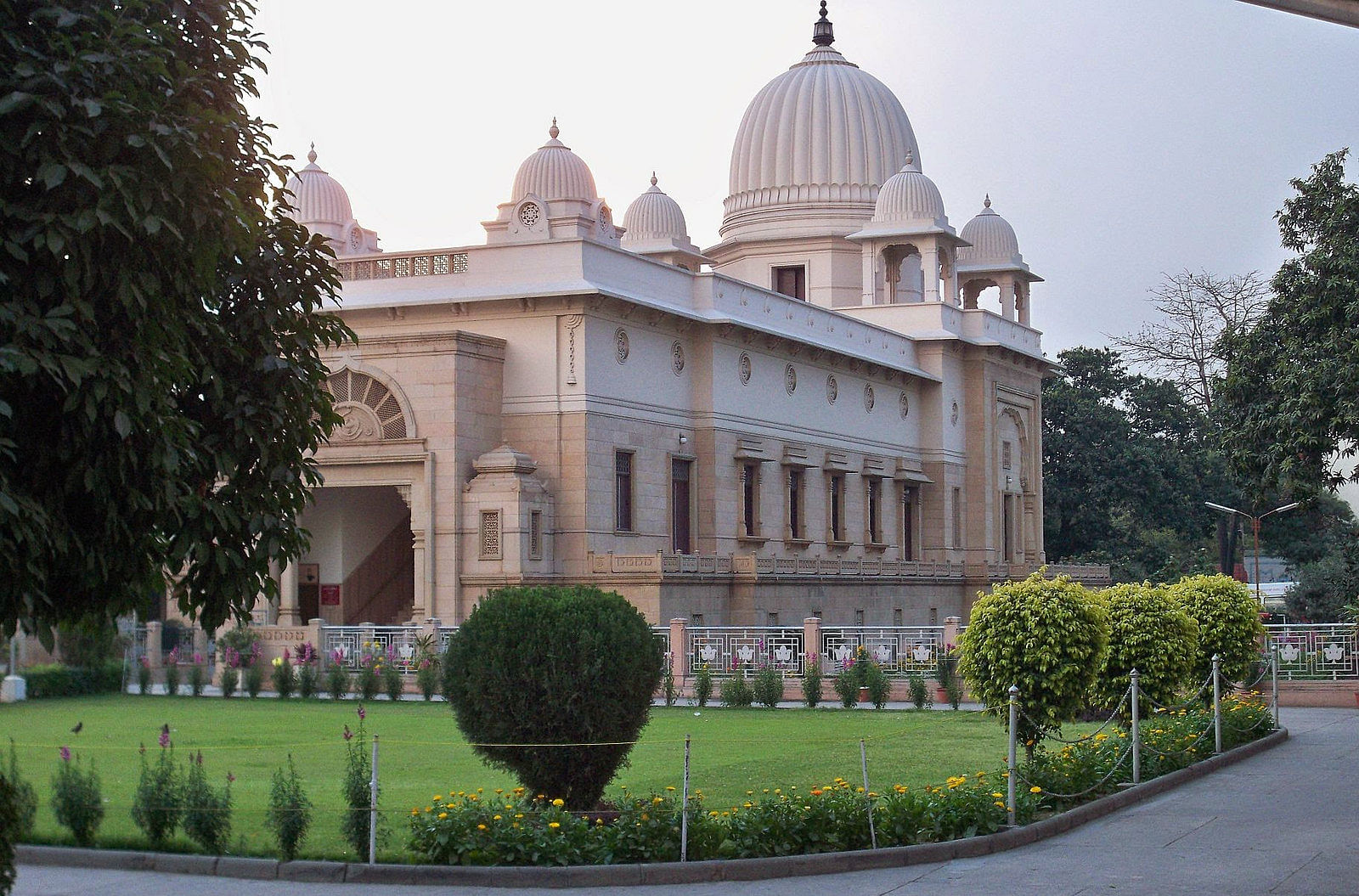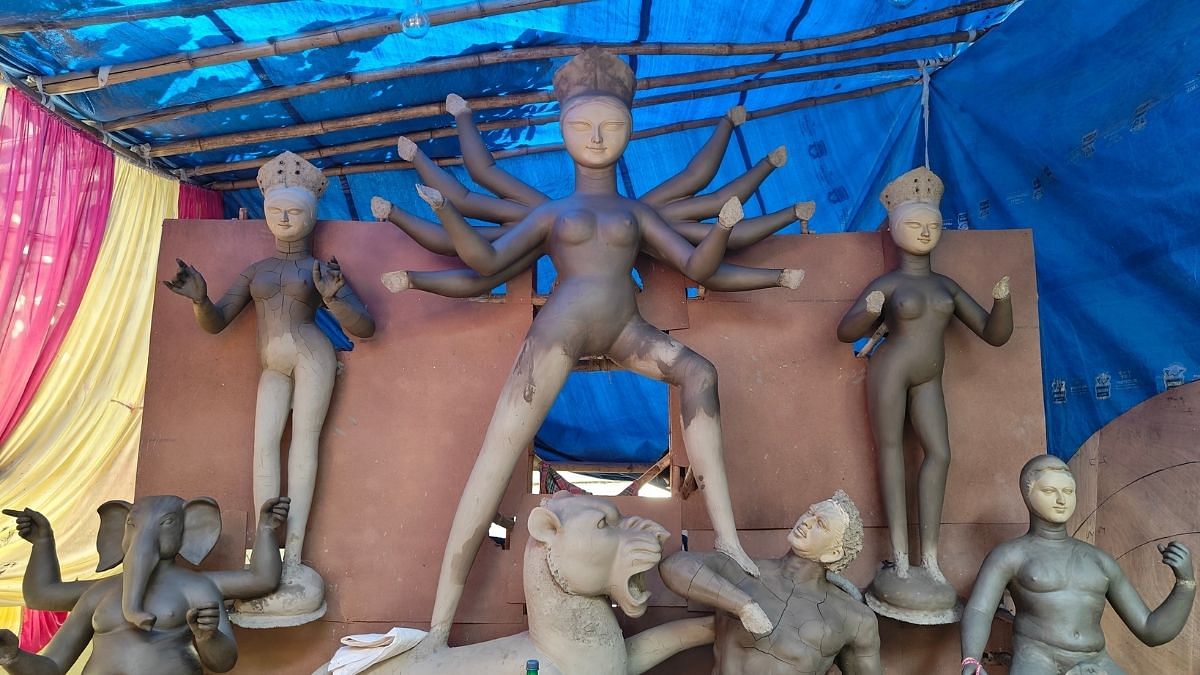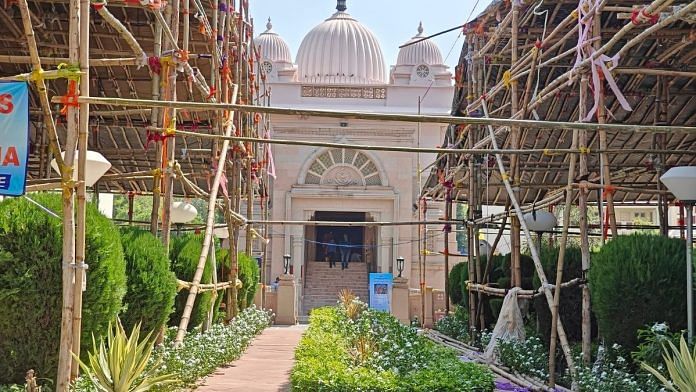New Delhi: With weeks to go before the 20 October bodhon of Devi Durga — the ritual which marks the formal beginning of the annual Durga Puja festivities for Bengalis — the campus of the Ramakrishna Mission in New Delhi was a flurry of activities on the last Saturday of September.
As a group of men worked on setting up a pandal near the entrance, a little distance away, Biswajit Pal, an idol maker from West Bengal’s Krishnanagar, was at work with his team, giving shape to the Durga idol. The mission staff stood around, calling out instructions, and generally soaking up the mood of celebration in the air.
“The Delhi Ramakrishna Mission was formally started in 1927; this is the 96th year of this centre. But this is the first time that we are celebrating Durga Puja here with idol worship,” said Swami Sarvalokananda, who took charge of the Delhi centre as secretary in May this year.
In previous years, a puja would be held in the campus only on Durga Ashtami (the eighth day of Navratri celebrations), when a pata (painting) of Goddess Durga would be worshipped and devotees would attend the Pushpanjali (a ritual which involves offering flowers to the Goddess) that day, Sarvalokananda added.
This year, however the Delhi Ramakrishna Mission will see a complete four-day Durga Puja (celebrated between Saptami, or the seventh of Navratri, to Dashami or Dussehra), with an idol of the goddess being worshipped.
Bodhan or awakening typically takes place a day before the Saptami puja.
The first ever Durga Puja at Belur Math, the headquarters of the Ramakrishna Mission and Ramakrishna Math, took place in 1901. “Today, it is celebrated at approximately 30 centres of the Mission,” said Swami Sarvalokananda.
While the New Delhi centre has been celebrating Kali Puja and Saraswati Puja for years, Durga Puja celebration has been a long-cherished dream here.
“For years, both the monks at the Delhi centre and the followers/devotees who visit, wanted to have the Durga idol worshipped here during the annual puja. When I came here in May, they also expressed this desire to me and I decided to act on it,” said the secretary of the Delhi centre.
A permission from Belur Math, necessary for any activity at any Mission centre, was received in August, and the centre immediately threw itself into preparations.
Belur Math didn’t respond to ThePrint’s email for a comment on the criteria for awarding permission and why it took the Delhi centre so long to start a Durga Puja celebration. The story will be updated if a response is received.
“Like at any centre, the puja here will also follow the Belur Math pattern,” said Swami Sarvalokananda.

Also read: UNESCO recognition of Durga Puja a big feat. But it was no easy journey for India
Durga idol at Belur
The Ramakrishna Mission was founded by Swami Vivekananda in 1897 with the twin purpose of spreading the Vedanta philosophy of his guru, Ramakrishna Paramahansa, and carrying out humanitarian and social services.
While it is not common for sanyasis (monks) to engage in such ritualistic worship, Vivekananda had his reasons for celebrating Durga Puja at Belur Math in 1901.
“Durga Puja was conducted on a small scale, without the image, by the disciples of Sri Ramakrishna during the early years of Ramakrishna Math at Baranagar,” mentions the Math’s website.
For one, Vivekananda was seeking acceptance of the local community for the order as the website notes.
The Hindu society of the time was yet to fully accept Vivekananda’s travel to the West (overseas travel was not religiously sanctified back then) and the pattern of life at Belur Math, “including the disregard of the caste system and free mixing with foreigners”.
The other reason was to “institutionalise respect for divinity of motherhood and sanctity of womanhood,” reads the Belur Math website.
“Durga Puja is worship of woman power and by celebrating Durga Puja, Swami ji [Vivekananda] wanted that power to be ignited in us,” said Sarvalokananda.
Vivekananda had also had had a vision of the puja being celebrate at Belur Math, according to the website.
Once he had decided to organise the puja, he sought permission from Sarada Devi, the spiritual consort of Ramakrishna Paramahansa, who was revered by Vivekananda as Sarada Ma, and continues to be regarded as such by the monks of the Ramakrishna Mission order. The Puja was held in her name.
According to the Belur Math website, Vivekananda was fond of agamoni music, which is sung in anticipation of the Goddess’ arrival. At the first Durga Puja at Belur Math, he sang agamonis himself. The tradition is carried on to this day, with monks at Belur gathering at the main temple and singing agamonis in the days leading to the puja.
The 1901 Durga Puja at Belur was a grand success. Disciples of Ramakrishna Paramahansa and Brahmins in the area had been invited. Thousands had gathered to participate in the celebration, irrespective of caste and religion.
The idea of idol worship wasn’t foreign to the Ramakrishna Mission order. Paramahansa was a Kali worshipper, said Tapati Guha-Thakurta, historian, honorary professor at the Centre for Studies in Social Sciences Kolkata and author of In the Name of the Goddess: The Durga Pujas of Contemporary Kolkata.
“The average Hindu of the time believed in idol worship. One reason for having a Durga puja at the Belur Math may have been to gain broader social acceptance for what was then a fledgling organisation. But it could also have served to set it apart from the Brahmo Samaj,” Guha-Thakurta added.
Today, Durga Puja is celebrated at many Ramakrishna Mission centres. They are like any other community puja pandals but without the spectacle, the commercial and consumerist trappings, associated with many of these pujas.
“There is none of the experimentation, or themes that characterise most community pujas today, and are closer to the barir pujas [family celebrations]. Of course, the Ramakrishna Mission followers and devotees visit, but I have known many people to visit Ramakrishna Mission centres only during the Durga Pujas,” she added.
Also read: Swami Vivekananda is not a Sangh Parivar icon. Liberal-progressives allowed his appropriation
A dream realised
For its first four-day Durga Puja celebration with an idol, the Delhi centre has drawn up an estimated budget of approximately Rs 60 lakh, according to Sarvalokananda.
“Devotees have donated generously and the centre is also contributing to the funds,” he said.
Committees have been formed to handle different puja-related works and the worship will be conducted by a Brahmachari (a person yet to become a monk) associated with the order. Devotees will be served prasad on the three days of Saptami, Ashtami and Navami.
“The USP of pujas at Ramakrishna Mission is that all rituals are followed very stringently. All centres follow the same rituals, as practiced at Belur Math, and our puja will be no different,” said Sarvalokananda.
The Bishuddha Siddhanta almanack is consulted for timings of pujas.
An interesting ritual at the Belur Math puja, which will be followed in Delhi, is Kumari Puja – worship of a young girl as a devi.

For the idol too, Pal said he has been asked to follow the Belur Math model. “It’s a traditional, ekchala protima,” said the idol maker.
Ekchala, which literally means “under one roof” is an idol of Durga with her four children – Kartik, Ganesh, Lakshmi and Saraswati – in one frame.
“I have been told that there are about 500 Durga Pujas organised in Delhi. But still, going by the enthusiasm among the devotees, I expect at least 10,000 people at the centre during the four-day celebration,” said Sarvalokananda.
(Edited by Ratan Priya)



